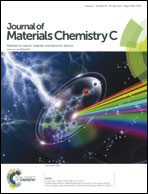Structural and luminescent properties of red-emitting Eu3+-doped ternary rare earth antimonates R3SbO7 (R = La, Gd, Y)
Abstract
The red-emitting Eu3+-doped rare earth antimonates R3SbO7 (R = La, Gd, Y) were prepared by high-temperature solid-state reaction. The crystal-phase formations were verified by X-ray powder diffraction (XRD) and structural refinements. The luminescence properties such as photoluminescence (PL) excitation and emission spectra, fluorescence decay curves, absolute luminescence quantum efficiency (QE), CIE color coordinates and the dependence of luminescence intensity on doping level were investigated. The luminescence QE, CIE color coordinates, and the spectrum characteristics of Eu3+ ions have a strong dependence on both R (La, Gd, Y) cations and Eu3+ doping levels. The 5D0 → 7F4 emission peak at 710 nm was the dominant transition in Eu3+-doped La3SbO7, while 5D0 → 7F0 at 580 nm was the strongest transition in Eu3+-doped Y3SbO7. The luminescence properties were discussed on the basis of the crystal structure. Different Eu3+ luminescence centers, such as isolated centers, pair broadening, and cluster centers, were discussed based on the dependence of the lifetime values on Eu3+ concentration. The luminescence QE of La3SbO7:0.4Eu3+ can reach 63.8% under excitation of UV light at room temperature; thus, it can have potential application as a red-emitting phosphor for solid-state lighting.


 Please wait while we load your content...
Please wait while we load your content...